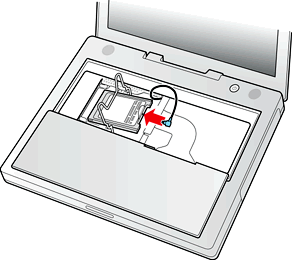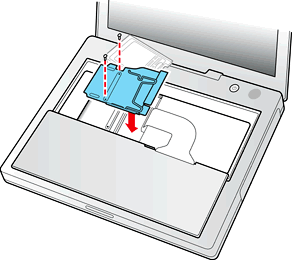Retired Document
Important: This document may not represent best practices for current development. Links to downloads and other resources may no longer be valid.
RAM Expansion
This chapter tells how to gain access to the RAM expansion slot in the iBook computer and then describes the RAM expansion module.
The RAM Expansion Slot
The iBook computer has one RAM expansion slot. To get access to the RAM expansion slot, the user must open up the computer by performing the following operations.
Shut down the computer.
Unplug the AC adapter from the computer.
Remove the battery from the computer.
Unlock the keyboard by turning the slotted screw that is part of the Num Lock LED, which is between the F5 and F6 function keys. Turning the screw 180 locks or unlocks the keyboard. (The locking screw may already be in the unlocked position.)
Release the two latches located at the top of the keyboard. One latch is between the ESC key and the F1 key; the other is between the F11 and F12 keys. Release the latches by sliding them toward the front of the computer. See Figure 3-5.
Pulling only on the latches (not on the keys), lift the keyboard up and turn it over, without disconnecting the keyboard’s membrane cable.
Remove the AirPort Card, if present, by unlatching the formed wire holder on the card, then pulling the flex tab to remove the module. The antenna cable should remain attached to the card. See Figure 4-1
Using a Phillips head screwdriver, remove the two screws that secure the metal RAM shield plate. The screws are to the right of the AirPort Card. See Figure 4-2.
Slide the metal RAM shield plate toward the rear of the computer, then lift it up and out of the computer.
If this is a 256-MB configuration, remove the 128-MB SO-DIMM currently occupying the memory expansion slot.


Once the RAM expansion module has been installed in the slot, the user must close up the computer by performing these steps in reverse order. Be careful to replace the shield plate properly so that the AirPort Card will fit.
If AC and battery power are removed for longer than ten minutes, the user may need to reset the computer’s clock (using the Data and Time control panel) when the computer is turned back on.
The RAM Expansion Module
The RAM expansion slot accommodates a standard SO-DIMM (small outline, dual inline memory module) that uses SDRAM devices.
An SO-DIMM for the iBook computer can contain either 128, 256, or 512 MB of memory. Maximum total RAM capacity using devices currently available is 640 MB and is limited by the space available for the SO-DIMM.
Mechanical Design of the RAM SO-DIMM
The mechanical characteristics of the RAM expansion module are given in the JEDEC specification for the 144-pin 8-byte DRAM SO-DIMM. The specification number is JEDEC MO-190-C. To find out how to obtain the specification, see RAM Expansion Modules.
The specification defines SO-DIMMs with nominal heights of 1.0, 1.25, 1.5, or 2.0 inches. The iBook can accommodate standard SO-DIMMs with a height of 1.0 or 1.25 inches.
The JEDEC specification defines the maximum depth or thickness of an SO-DIMM as 3.8 mm. That specification is also a maximum: Modules that exceed the specified thickness can cause reliability problems.
Electrical Design of the RAM SO-DIMM
The electrical characteristics of the RAM SO-DIMM are given in section 4.5.6 of the JEDEC Standard 21-C, release 7. To find out how to obtain the specification, see RAM Expansion Modules.
The specification defines several attributes of the DIMM, including storage capacity and configuration, connector pin assignments, and electrical loading. The specification supports SO-DIMMs with either one or two banks of memory.
The JEDEC specification for the SO-DIMM defines a Serial Presence Detect (SPD) feature that contains the attributes of the module. SO-DIMMs for use in the iBook are required to have the SPD feature. Information about the required values to be stored in the presence detect EEPROM is in section 4.1.2.5 and Figure 4.5.6–C (144 Pin SDRAM SO–DIMM, PD INFORMATION) of the JEDEC standard 21-C specification, release 7.
SDRAM Devices
The SDRAM devices used in the RAM expansion modules must be self-refresh type devices for operation from a 3.3-V power supply. The speed of the SDRAM devices must be 100 MHz or greater, corresponding to a cycle time of 10 ns or less.
The devices are programmed to operate with a CAS latency of 2. At that CAS latency, the access time from the clock transition must be 7 ns or less. The burst length must be at least 4 and the minimum clock delay for back-to-back random column access cycles must be a latency of 1 clock cycle.
Configuration of RAM SO-DIMMs
Table 4-1 shows information about the different sizes of SO-DIMMs used in the iBook computer. The first three columns show the memory size, configuration, and number of banks in the SO-DIMMs. The other three columns show the number, density, and configuration of the SDRAM devices making up the memory modules.
Address Multiplexing
Signals A[0] – A[12] and BA[0] – BA[1] on each RAM SO-DIMM make up a 15-bit multiplexed address bus that can support several different types of SDRAM devices. Table 4-2 lists the types of devices that can be used in the iBook by size, configuration, and sizes of row, column, and bank addresses.
RAM SO-DIMM Electrical Limits
Each RAM SO-DIMM must not exceed the following maximum current limits on the +3 V supply:
Active: 1.2 A (maximum of 8 devices per bank, 150 mA per device)
Sleep: 12 mA (total for all banks)
The maximum current specified for active operation generally rules out the use of 4-bit-wide SDRAM devices in a RAM expansion module. Such a module would have 16 such devices per bank, and the 1.2 A maximum current would allow only about 75 mA per device. To stay within the current limits, RAM expansion modules should use only 8-bit or 16-bit SDRAM devices.
Copyright © 2007 Apple Inc. All Rights Reserved. Terms of Use | Privacy Policy | Updated: 2007-05-03